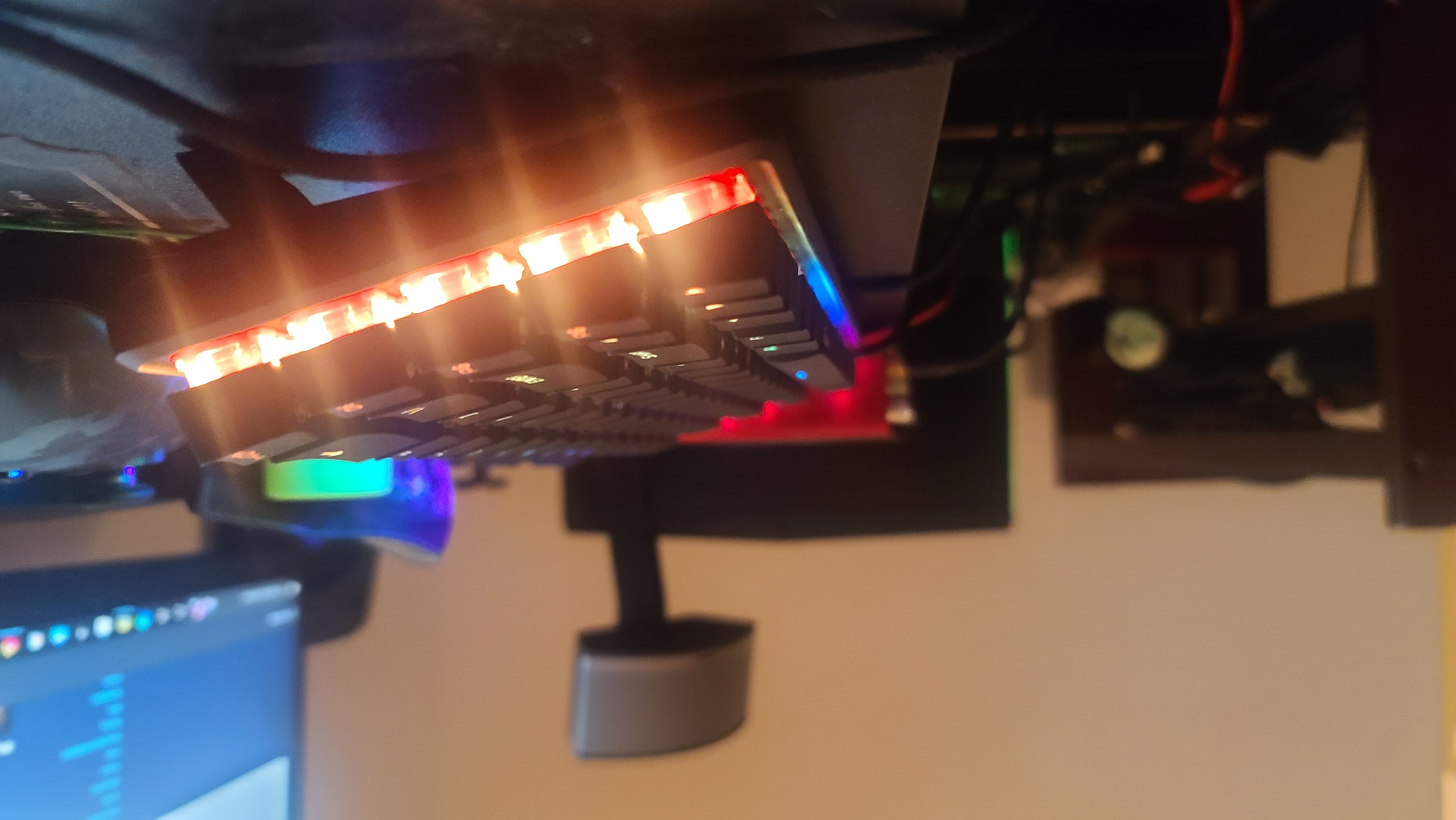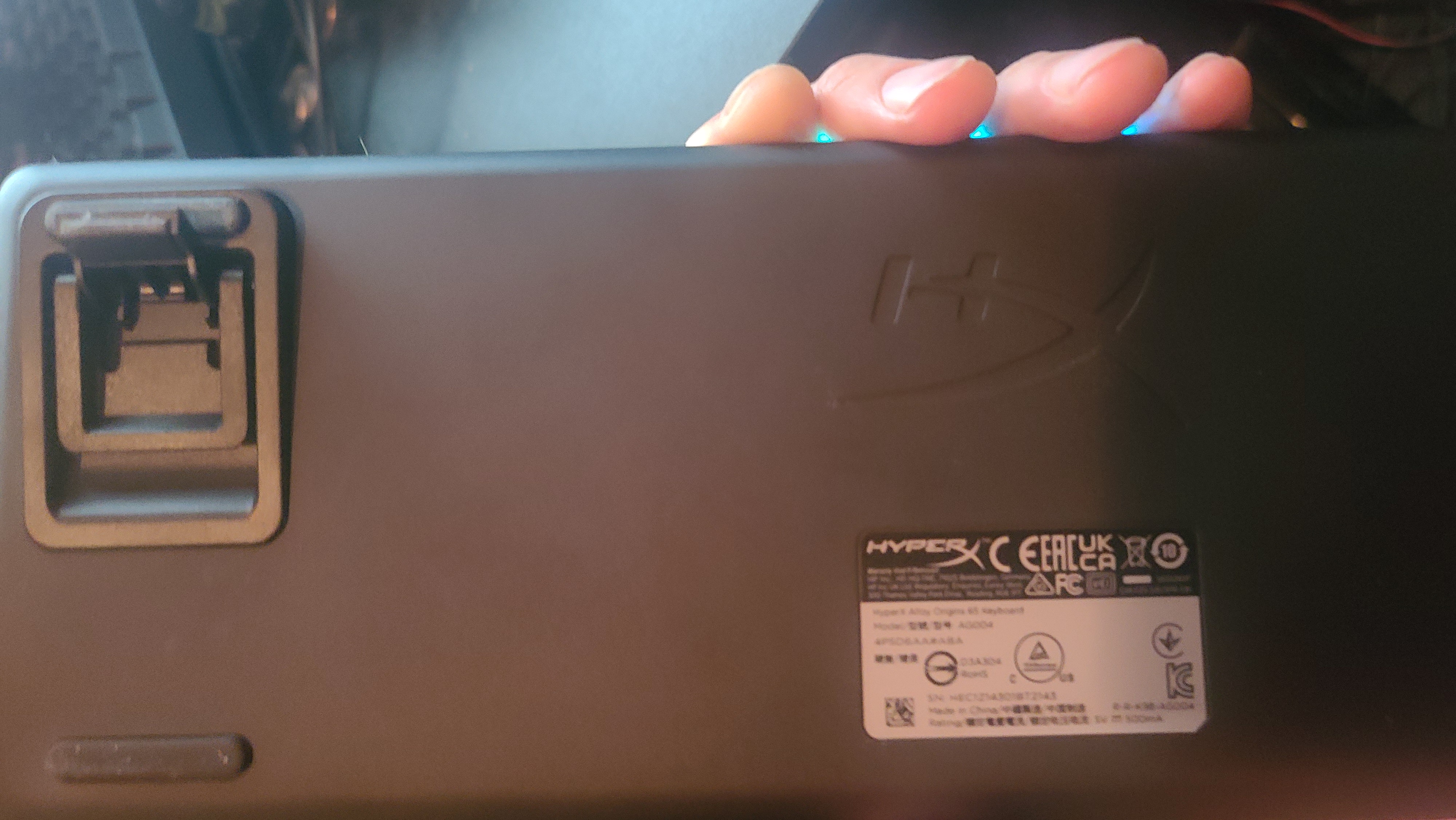Tom's Hardware Verdict
HyperX’s Alloy Origins 65 is a well-built, stripped-down gaming weapon. Its space-saving design allows it to fit just about anywhere and leaves you plenty of desk real estate.
Pros
- +
Extremely well built
- +
Great feeling switches
- +
Solid and weighty
- +
Vibrant, colorful RGB
Cons
- -
Fairly average software
- -
65 percent form factor not for everyone
Why you can trust Tom's Hardware
The 65-percent form factor keyboard has been gaining popularity with gamers thanks to its small footprint and greater portability. But what you gain in space you lose in functionality: While most of the familiar functions of a full-size keyboard are usually present, you’ll need to use the Fn key to access them.
The HyperX Alloy Origins 65 joins HyperX’s Alloy Origins lineup as the slight step-up, size-wise, from the year-old HyperX Alloy Origins 60. The 65-percent Alloy Origins 65 is still ultra-compact, but — unlike its 60-percent sibling — sports arrow keys as well as a handful of navigation keys.
Like its competitors on our list of best gaming keyboards, the HyperX Alloy Origins 65 is first and foremost a keyboard for gamers, and it’s wonderfully suited to the task. There are nods to its non-gaming use — the Fn keybinds are printed on the keycaps and easy to see — but the limitations of the 65-percent layout might be a turn-off for those prioritizing productivity.
This sturdy little keyboard is portable, saves space, and feels great. It’s designed for a niche audience, but the Alloy Origins 65 feels good enough that you might consider it worth the limitations.
HyperX Alloy Origins 65 Specs
| Switches | HyperX Red ( also available with HyperX Aqua Tactile Switches) |
| Lighting | Per-key RGB |
| Onboard Storage | Up to 3 profiles |
| Media Keys | With FN |
| Interface | USB Type-A |
| Cable | 5.25 feet / 1.6m |
| Additional Ports | None |
| Keycaps | PBT |
| Construction | Aluminum Body |
| Software | HyperX NGENUITY |
| Dimensions (WxDxL) | 12.4 x 4.15 x 1.45 inches/ 315 x 105.5 x 36.9 mm |
| Weight | 1.82lb / 827.7g |
Design of the HyperX Alloy Origins 65




The HyperX Alloy Origins 65 is a compact, tenkeyless (TKL), 65-percent keyboard that is as solidly constructed as it is space-saving. The diminutive body is made from solid aluminum and weighs roughly two pounds despite its very small footprint. There is zero flex present in the body – this is one solid chunk of metal. On the underside of the keyboard, there are flip-out feet that allow for two additional angles other than simply laying the board flat. The shorter feet lift the back of the keyboard 1.75 inches (44.45mm) off of the desk surface and the longer feet lift the back of the board 2.25 inches (57.15mm).
F Key and Media Control functions are available via Fn and are clearly etched on the side of the keys facing the user. HyperX also includes alternate ESC and Spacebar keycaps along with a keycap puller for those who want to further customize the look of their keyboard. HyperX’s own switches are similar in design to Cherry MX and Kailh switches, so they’ll be compatible with any keycaps designed for a Cherry MX style stem.
The Alloy Origins 65 is wired, and connects to your PC via a detachable 6-foot (3m) braided USB-C to USB-A cable, which enhances the keyboard’s portability by eliminating the possibility of cable snarls.
The Alloy Origins 65 is sleek, small, and attractive, with vibrant per-key RGB lighting accenting its minimalist design. The switch stems are exposed and allow the RGB lighting to spill out from under the keycaps, which makes the Alloy Origins 65 a great choice for low light environments. The entire keyboard is finished in a matte black, including the plate covering the PCB where the switches are mounted. This creates a sleek, uniform look and helps reduce glare from the RGB lighting. It’s a great-looking keyboard that will mesh well with a variety of different setups.
Get Tom's Hardware's best news and in-depth reviews, straight to your inbox.
Typing Experience on the HyperX Alloy Origins 65
The HyperX Alloy Origins 65 ships with either HyperX Red or Aqua switches, which are very similar to Cherry MX’s linear Red and tactile Brown switches, respectively. Our review unit shipped with HyperX Red switches. The main difference between HyperX’s switches and Cherry MX’s switches is that the former have a slightly shorter actuation distance of 1.8mm (versus the Cherry MX’s 2mm) and have a longer rated lifespan of 80 million keystrokes (versus the Cherry MX’s 60 million).
We can’t really offer concrete proof of HyperX’s claims of superior durability because there’s no way we could hit a key 80 million times and review it anytime soon, but we can say that the HyperX Red switches feel as sturdy as their Cherry MX counterparts. Likewise, the slightly shorter actuation travel isn’t something that felt or performed noticeably different. This difference may be more noticeable in a tactile switch but with a linear switch type like reds where you are more likely to be bottoming out your keys while typing, it’s hard to tell.
In a side by side comparison using the 10fastfingers.com typing test, I scored between 70 and 75 WPM on both HyperX and Cherry Reds, down from my usual score of between 80 and 85 WPM using tactile switches. This probably says more about my preference for tactile over linear switches for typing, but as for the performance of HyperX Red switches versus Cherry MX Red switches: The difference, if any, is negligible.
Gaming Experience on the HyperX Alloy Origins 65
The HyperX Alloy Origins 65 performs admirably in gaming, along the lines of what you’d expect from a high performance keyboard sporting linear switches. Similar to Cherry MX Reds, the HyperX Reds enable fast gameplay response and “double tapping” due to the mechanism not needing to reset with each actuation like a tactile switch does. The 0.2mm shorter travel distance to the HyperX Red switch’s actuation point did not produce radically different results in gameplay than I have experienced with Cherry MX Reds.
I tested the HyperX Alloy Origins 65 in DOTA2 and Counterstrike:GO and I was very happy with how responsive it was, though I am admittedly firmly in the tactile switch camp when it comes to both typing and gaming. The HyperX Red switches are extremely fast, though I can’t say they are any faster than the more-established Cherry MX Reds — but I also can’t say they’re any slower. As far as I’m concerned, HyperX Red switches are essentially identical to the industry standard Cherry MX Red switches, performance-wise.
Software on the HyperX Alloy Origins 65
HyperX’s NGENUITY Software remains a very no-frills affair. From within NGENUITY, you can choose between seven different lighting effects ( Breathing, Confetti, Swipe, Solid, Twilight, Wave, and Sun ) and tweak several parameters, including opacity (brightness ), speed, and whether to assign the lighting to all keys or to specific keys of your choice. Effects can be mixed and matched and “triggered” effects ( Flame, Explosion, Fade — activated by typing ) can be combined with your preferred lighting profile for added flair.
Each individual key is remappable and can be assigned macros. This is all very simple to achieve with NGENUITY’s intuitive and uncluttered interface. Pre-fabbed profiles can also be downloaded from HyperX’s website for import into your saved profiles if you’d rather not spend too much time messing around with settings on your own. These often correspond to a popular title or eSports organization.
NGENUITY has come quite a long way since I last worked with it in a professional capacity, with quality-of-life improvements centered around how profiles are saved (this used to be buggy, unintuitive, and inconsistent). However, despite how well things work now, I did find myself wishing there were more options to work with in terms of lighting effects. While you can certainly achieve some impressive displays with the vibrant effects on offer, nothing here rivals the flexible customization options you’ll find in Corsair’s iCUE or Razer’s Chroma.
Bottom Line
The HyperX Alloy Origins 65 gaming keyboard offers everything a competitive gamer could want in a small, convenient package that doesn’t skimp on build quality. There are nice, thoughtful design touches, such as etched Fn-enabled functions facing you and a set of two feet under the keyboard body for tilting the keyboard at two (three if you include the default) different angles. The PBT keycaps have a great, smooth feel to them and the RGB lighting is bright and striking without being seizure-inducing.
HyperX has made a lot of noise about their proprietary switches and while they are certainly comparable in feel to the more well-known Cherry MX switches, the slightly shorter travel distance to actuation didn’t produce meaningfully improved results in typing or gaming over their established competition. We also couldn’t verify the additional 20 million keystroke lifespan within the time allotted to provide this review to the public (but the switches did have a solid feel).
NGENUITY is a much improved software package after having had more time to develop but it is still a little bare bones compared to Corsair’s iCUE and Razer’s Chroma and Synapse packages. Being able to tell when you’ve saved your changes to a set of lighting effects is something that should have been present from NGENUITY’s release; it’s nice to see that HyperX is committed to improving the software.
HyperX’s Alloy Origins 65 has very few flaws, apart from the fact that it’s built for a relatively niche audience. Compact, 65-percent keyboards are built primarily for competitive gamers (and also appeal to people with limited desk space), but many will find that the compromises inherent to the layout to be a hindrance when it comes to productivity tasks. The keyboard is certainly comfortable to type on and amazing in terms of space-saving, but I can’t see myself using this as my daily driver to perform data entry tasks.
Some may feel that, at $99.99, the Alloy Origins 65 is not a lot of keyboard for their money, but if you’re looking for a compact keyboard this is a well-built, stripped-down gaming board that punches above its weight class. If you’re looking for a compact, portable keyboard that’s more productivity-oriented, the $149 Logitech MX Mechanical Mini is slim, wireless, and has productivity features through Logitech’s Logi Options+ software. If you’d rather get more keyboard for your buck, check out our sub-$80 list of best budget mechanical keyboards.

Nate Rand is a freelance reviewer for Tom's Hardware US, covering gaming headsets, keyboards, mice, and microphones.
-
mikeebb I'm pleasantly surprised by HyperX in general. Recently had to replace an old Knucker keyboard that died. HyperX "Alloy Core" (full-size, not compact) was very cost-effective, has an excellent typing feel even without being fully mechanical (much better than the old Knucker), hefty enough to stay in place better than the old one, and works well without extra software (that's a selling point for me). Fully backlit, which helps at night. Odd, though, that the key markings are invisible if the backlight is off - does this keyboard do the same thing?Reply
Full disclosure: I'm not much of a gamer; keyboard is used mainly for "productivity."
